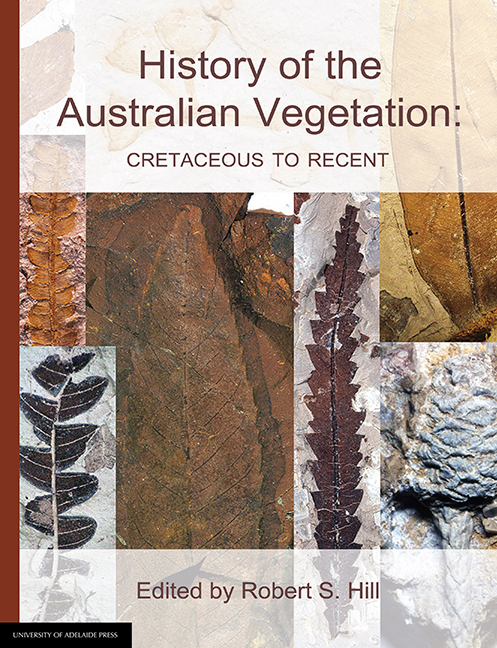Book contents
- Frontmatter
- Contents
- List of contributors
- Introduction to the 2017 edition
- 1 The Australian fossil plant record: an introduction
- 2 Maps of late Mesozoic-Cenozoic Gondwana break-up: some palaeogeographical implications
- 3 The background: 144 million years of Australian palaeoclimate and palaeogeography
- 4 Palaeobotanical evidence for Tertiary climates
- 5 Landscapes of Australia: their nature and evolution
- 6 Patterns in the history of Australia's mammals and inferences about palaeohabitats
- 7 Australian Tertiary phytogeography: evidence from palynology
- 8 Cretaceous vegetation: the microfossil record
- 9 Cretaceous vegetation: the macrofossil record
- 10 Early Tertiary vegetation: evidence from spores and pollen
- 11 The early Tertiary macrofloras of continental Australia
- 12 Cenozoic vegetation in Tasmania: macrofossil evidence
- 13 The Neogene: a period of transition
- 14 The Oligo-Miocene coal floras of southeastern Australia
- 15 Quaternary vegetation
- 16 The history of selected Australian taxa
- Taxonomic index
- General index
8 - Cretaceous vegetation: the microfossil record
Published online by Cambridge University Press: 25 July 2017
- Frontmatter
- Contents
- List of contributors
- Introduction to the 2017 edition
- 1 The Australian fossil plant record: an introduction
- 2 Maps of late Mesozoic-Cenozoic Gondwana break-up: some palaeogeographical implications
- 3 The background: 144 million years of Australian palaeoclimate and palaeogeography
- 4 Palaeobotanical evidence for Tertiary climates
- 5 Landscapes of Australia: their nature and evolution
- 6 Patterns in the history of Australia's mammals and inferences about palaeohabitats
- 7 Australian Tertiary phytogeography: evidence from palynology
- 8 Cretaceous vegetation: the microfossil record
- 9 Cretaceous vegetation: the macrofossil record
- 10 Early Tertiary vegetation: evidence from spores and pollen
- 11 The early Tertiary macrofloras of continental Australia
- 12 Cenozoic vegetation in Tasmania: macrofossil evidence
- 13 The Neogene: a period of transition
- 14 The Oligo-Miocene coal floras of southeastern Australia
- 15 Quaternary vegetation
- 16 The history of selected Australian taxa
- Taxonomic index
- General index
Summary
During the past decade, the three-element invasion theory that was initially advocated by Hooker (1860) to explain the present-day Australian flora has been questioned or dismissed (Barlow, 1981; Webb et al, 1986). Current concepts developed from ecological evidence indicate autochthonous differentiation from an ancient Gondwanan flora during the Late Cretaceous and early Tertiary (Webb et al, 1986). However, Truswell et al (1987) believed that the pollen record known to them favoured a Late Cretaceous- early Tertiary phase of floristic exchange between Australia and regions to the north, with dispersal occurring in both directions. Evidence that countered invasion from the north during the Late Cretaceous has since accrued (Dettmann & Thomson, 1987; Dettmann & Jarzen, 1988, 1990; Dettmann, 1989; Dettmann et al, 1990; Jarzen & Dettmann, 1990). From patterns of pollen introductions in separate regions of the southern Gondwana assembly, it was concluded that many elements of the Australian Cretaceous flora either evolved within the Austro-Antarctic region or entered Australia using an Antarctic route (Dettmann, 1989; Dettmann & Jarzen, 1990), as had been suggested previously (Dettmann, 1981).
The earliest angiosperms in Australia were almost certainly immigrants. The pollen record emphasises a 5-10 million years (Ma) time lag between initial inceptions of angiosperms in the southern Laurasian-northern Gondwanan region (Hauterivian or earlier) than introduction in Australia (late Barremian-Aptian). This evidence argues against Australia as a cradle region of the angiosperms (Takhtajan, 1969) and provides little support for inception and diversification of earliest angiosperms on fragments of the Australian plate that rafted northwards during the Late Jurassic (Takhtajan, 1987). Migration routes taken by the early angiosperms to Australia probably involved southern Gondwana (Dettmann 1981, 1989; Truswell et al, 1987); dispersal to Australia from Southeast Asia via microcontinents detached from northern Australia (Burger, 1981, 1990) has scant support from the pollen record.
The issues of introduction and Late Cretaceous differentiation of angiosperms in Australia are explored here using up-to-date pollen evidence. This evidence, combined with knowledge of palaeogeography and palaeotemperatures, has provided a basis for interpreting floristics and structure of Cretaceous plant communities represented in Australia.
- Type
- Chapter
- Information
- History of the Australian VegetationCretaceous to Recent, pp. 143 - 170Publisher: The University of Adelaide PressPrint publication year: 2017



